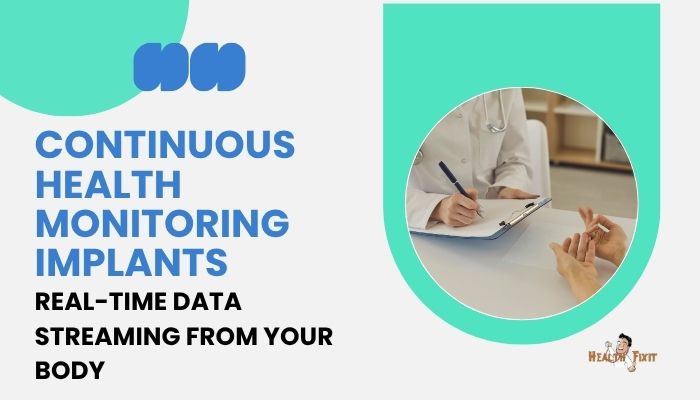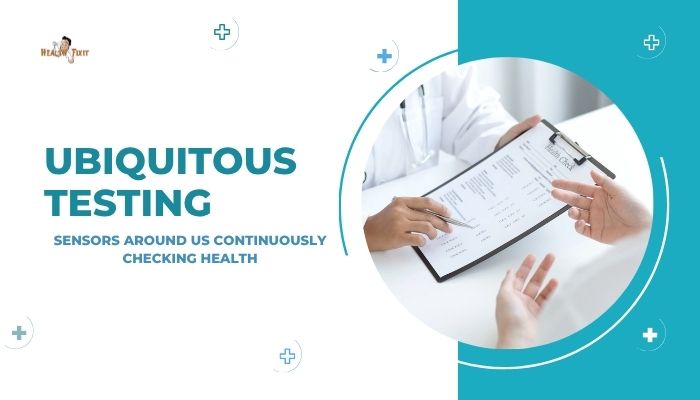Introduction
Wearable health trackers and smartwatches have become widespread, but what if we went a step further—implanting sensors directly inside the body to monitor vital signs or detect disease in real time?
The idea of continuous health monitoring implants promises more accurate, 24/7 data flows that could revolutionize how we manage chronic conditions and respond to acute issues
. Imagine receiving an immediate alert on your phone about rising blood sugar or early signs of infection. While this vision is no longer just science fiction, it brings significant engineering, regulatory, and ethical considerations.
This article explores the technology behind implantable health monitors, their potential benefits for patients, and the challenges we must overcome before they become mainstream.
Why Implantable Monitoring?
Limitations of External Devices
Wristbands, rings, or chest straps can collect heart rate, sleep patterns, or step counts, but they may slip off, lose skin contact,
or yield partial data. Many can’t track deeper metrics like core temperature, continuous hormone levels, or direct blood chemistry. Implantables bypass these constraints, offering stable measurements without user intervention.
Better Adherence and Accuracy
Patients often forget or dislike wearing external monitors, or they only measure intermittently. An implant is always-on,
requiring minimal daily input. Its direct contact with tissue or blood yields consistent, high-quality signals. For critical conditions—like diabetes or heart failure—this real-time accuracy can be life-saving.
Early Warning Systems
With continuous data streaming, doctors or AI algorithms can detect subtle anomalies—like arrhythmias or rising inflammatory markers—before symptoms emerge. This approach fosters proactive interventions, potentially preventing hospitalizations.
Types of Implantable Sensors
Glucose Monitors for Diabetes
Continuous glucose monitoring (CGM) devices are among the most established implants. Placed just under the skin,
they measure interstitial glucose levels. Patients can adjust insulin doses based on real-time readings, drastically improving glycemic control.
While many CGMs are still “wearable patches,” fully subdermal implants that last for months are becoming more common.
Cardiac and Hemodynamic Sensors
Some advanced sensors track intracardiac or arterial pressure in real time, helping manage heart failure or hypertension.
They wirelessly transmit data to a receiver, guiding medication adjustments. In certain studies, these implants significantly reduce readmissions for heart failure.
Biochemical Analyzers
Prototypes exist for monitoring an array of biomarkers—like lactate, cortisol, or specific cytokines—in real time. By coupling with microfluidic channels or enzymatic detection
, these implants can measure subtle changes in blood or interstitial fluid. While still experimental, future versions could detect infection markers or metabolic shifts instantly.
How Continuous Monitoring Works
Power and Communication
Implants may draw power from small batteries (lasting months or years) or use wireless charging. Data transmits wirelessly (Bluetooth-like or inductive links) to a smartphone or dedicated receiver.
Minimizing energy use is critical to prolong device longevity without frequent surgeries for battery replacement.
Data Processing and Alerts
Raw sensor signals often feed into local algorithms that distill relevant metrics (e.g., average glucose over the past hour).
Detailed data might also upload to secure cloud servers, enabling doctors or AI systems to analyze trends. If certain thresholds are crossed, an automatic alert prompts user or provider intervention.
Integration with EHR Systems
For stable data flow, these implants can connect with electronic health record (EHR) platforms, letting clinicians remotely track patients. Sophisticated dashboards might rank patient risks, assisting telemedicine or triage decisions.
Potential Benefits for Healthcare
Improved Chronic Disease Management
Day-to-day real-time data can transform conditions like diabetes, heart failure, or kidney disease from crisis-prone to proactively managed. Subtle changes in lab values or vitals flag the need for medication tweaks, diet changes, or a quick telehealth consult—reducing complications.
Personalized Therapies
Over time, robust data sets let doctors tailor treatment regimens, pinpointing which interventions truly help each patient. Predictive analytics might even forecast future flare-ups or relapses, guiding preemptive therapy.
Enhanced Clinical Research
Continuous implants produce huge volumes of data. Researchers can glean better insights into disease progression or drug effects.
This knowledge might accelerate drug trials, leading to more nuanced dosing or better-targeted therapies.
Challenges and Caveats
Biocompatibility and Safety
Any implant must be biocompatible, resisting inflammation or rejection. Over months or years, material degradation, infection risk, or fibrous tissue encapsulation can degrade signal quality or cause device failure. Rigorous design and robust clinical tests are vital.
Security and Privacy
Data from inside the body is deeply personal. Breaches or hacks might reveal intimate health info. Implant designs must incorporate strong encryption and security protocols to avert unauthorized access or manipulation of device functions.
Regulatory Path
Regulators like the FDA and EMA have strict standards. Each new device—particularly if it claims to reduce morbidity—requires thorough demonstration of safety, reliability, and clinical benefit. The bar is high for Class III medical devices that remain inside the body long term.
The Future of Monitoring Implants
Multifunction “Lab in the Body”
Some labs envision single implants measuring multiple biomarkers—sugar, cholesterol, hormones, even cancer markers.
This “lab in the body” might provide a complete daily health snapshot. Achieving stable, multi-sensor arrays with minimal power demands is a major engineering challenge, but progress continues.
Merging with AI
As data accumulates in real time, machine learning can interpret patterns, customizing interventions. This synergy might evolve “digital twins,” where virtual models replicate a patient’s physiology. Adjustments in the model can hint at real-world therapy changes, all guided by continuous device data.
Toward Tissue-Integrated Electronics
Advances in flexible or biodegradable electronics could yield implants that seamlessly blend with tissues, removing the rigid,
foreign sensation and reducing immune response. Over time, such “electronic tattoos” or “smart tissues” might vanish once the job is done, simplifying removal concerns.
Practical Considerations for Adoption
- Assess Clinical Utility: Not all patients need invasive implants; weigh the benefits against surgical risk. More extreme conditions might justify advanced continuous monitoring.
- Choose Reputable Vendors: Evaluate device track records, FDA approvals, data security measures, and real-world evidence of performance.
- Involve Providers: Ensure your care team can interpret or integrate streaming data into your care plan. If clinicians lack the infrastructure to handle continuous feeds, the device’s advantage diminishes.
- Plan for Upgrades: Many implants have a finite lifespan or battery. Patients may need periodic replacement or calibration. Set realistic expectations about maintenance intervals.
Conclusion
Continuous health monitoring implants promise a future where advanced sensors track vitals or biochemical markers from within
, enabling near-instant alerts and personalized interventions. Such devices could radically improve chronic disease management,
usher in more proactive care, and help us pivot from episodic checkups to seamless, daily vigilance.
Yet forging this path demands overcoming engineering, regulatory, and ethical hurdles—ensuring these always-on implants are safe
, data-secure, and accessible to those who need them. As the underlying technologies mature, we may soon rely on these implants as quiet, ever-present guardians of our well-being.
References
- Abreu G, et al. In-body continuous monitoring of blood biomarkers: a review of recent sensor technologies. Biosens Bioelectron. 2021;188:113319.
- Rodgers MS, et al. Long-term implantable biosensors for continuous measurement: challenges and future directions. Med Devices. 2020;13:313–322.
- Mirmohseni S, Khalilzadeh MJ. Emerging sensor materials for implantable devices. Adv Mater. 2019;31(42):e1902056.
- Jafari R, et al. Wearable and implantable continuous monitoring: bridging the gap to predictive analytics. IEEE Trans Biomed Eng. 2021;68(3):851–864.
- Hwang T, Song JW. Designing the near future of implantable, real-time monitoring in telehealth. Telemed e-Health. 2022;28(9):1191–1198.
- Czopek A, Wroblewska J. Ethical considerations of continuous monitoring implants. J Med Ethics. 2021;47(7):501–506.
- Lhotska L, et al. Data privacy and security in long-term in vivo sensors. Stud Health Technol Inform. 2020;270:49–54.
- Tang T, Proctor J, Youngblood T. Future of cardiac implants for congestive heart failure management. Heart Fail Clin. 2021;17(4):735–743.
- Mannino RG, Myers DR, et al. Real-time blood analytics: next generation biomonitoring from the inside out. Lab Chip. 2018;18(16):2344–2351.
- Kim J, Campbell AS, de Ávila BE, Wang J. Wearable biosensors for healthcare monitoring. Nat Biotechnol. 2019;37(4):389–406.



